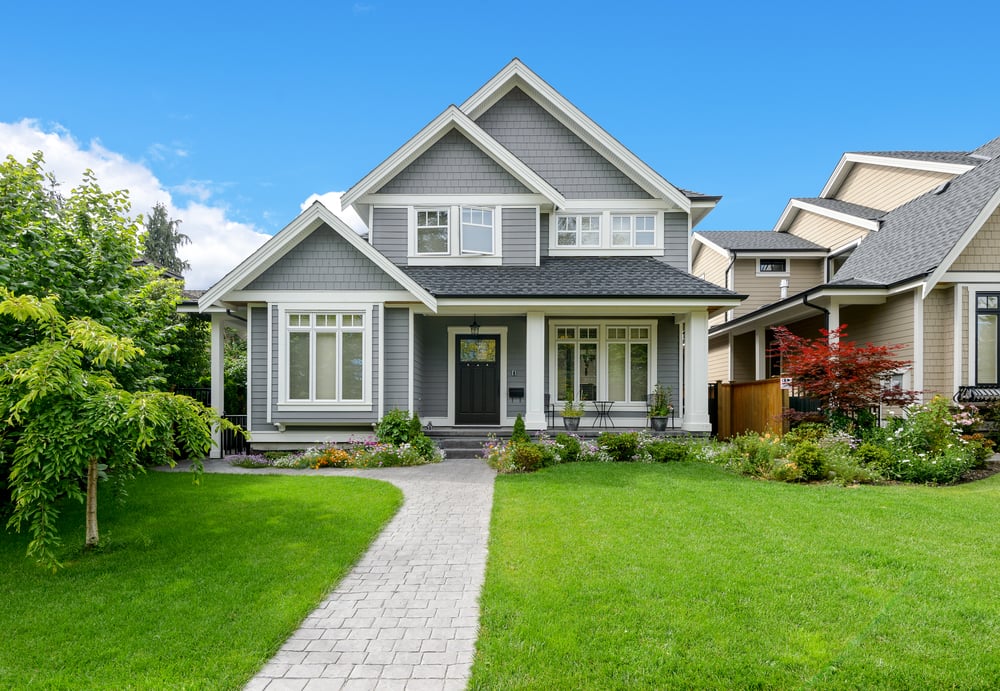1. The Allure of Space and Community
Suburban life often centers around the desire for larger homes, yards for children and pets, and a sense of community. Trading the density and fast pace of city life for a more relaxed environment is a common motivation. The image of tree-lined streets and neighborhood gatherings contributes to the appeal. Data reveals a continued interest in suburban living, with housing stock in suburban areas steadily increasing. For instance, between 2023 and 2024, Maricopa County, AZ, added 38,000 housing units, Los Angeles County, CA, added 32,000, and Harris County, TX, added 29,000. Across the United States, housing stock increased by 1.4 million units during the same period, reaching a total of 146.8 million.
However, this pursuit of the “American Dream” often comes with trade-offs. While the promise of more space and potentially greater affordability can be enticing, factors like longer commutes and increased reliance on personal vehicles must also be carefully considered. Finding a balance between lifestyle aspirations and practical considerations is essential for a successful transition to suburban living. The presence and influence of Homeowners Associations (HOAs) are also increasingly common in these communities, adding another layer of complexity to the decision-making process.
2. Navigating the HOA Landscape
Homeowners Associations (HOAs) have become a defining feature of many suburban neighborhoods. These organizations establish and enforce rules related to property appearance and resident behavior, aiming to maintain community standards and property values. As suburban developments increasingly incorporate mandatory community governance, understanding the implications of HOA membership is crucial for prospective homebuyers.
Living in an HOA community offers potential benefits, such as enhanced security, shared amenities (like pools, parks, and community centers), and the potential for increased property values due to consistent neighborhood upkeep. However, these advantages come with restrictions on personal freedom. Homeowners may face limitations on landscaping choices, exterior modifications (paint colors, additions), and even the types of vehicles they can park on their property.
The key challenge for homeowners in HOA communities lies in balancing the collective benefits of community governance with individual autonomy. Potential homebuyers should carefully review HOA rules and regulations before purchasing a property to ensure they are comfortable with the restrictions and financial obligations. Open communication with the HOA board and active participation in community meetings can help navigate potential conflicts and ensure a harmonious living experience.
3. The Commute Conundrum and its Impact
While suburban living offers the allure of tranquility and spaciousness, it often comes with a significant trade-off: the daily commute. The distance between suburban homes and urban job centers can lead to longer travel times, impacting work-life balance and overall well-being. Many suburbs function as commuter towns, where residents endure extended travel in exchange for more affordable or desirable housing.
Prolonged commutes can negatively affect both physical and mental health. Research suggests that longer travel times are associated with decreased life satisfaction, increased stress levels, and even increased risk of cardiovascular problems. The stress of navigating traffic, dealing with delays, and the sheer time commitment can erode the perceived benefits of suburban living. Data from Visual Capitalist indicates that some of the longest average one-way commutes in the United States occur in suburban areas. In 2024, Palmdale, California, topped the list with an average commute time of 45.5 minutes. Other suburban cities with long commutes include Moreno Valley (35 minutes), Corona (34.2 minutes), and Fontana (33.3 minutes), all located in California. Even major cities like New York (40.7 minutes) and Chicago (33.5 minutes) have significant commute times, highlighting the widespread nature of this challenge.
| Rank | City | State | Average Commute (minutes, one-way) |
| 1 | Palmdale | California | 45.5 |
| 2 | New York | New York | 40.7 |
| 3 | Jersey City | New Jersey | 37.4 |
| 4 | Yonkers | New York | 36.4 |
| 5 | Moreno Valley | California | 35 |
| 6 | Corona | California | 34.2 |
| 7 | Chicago | Illinois | 33.5 |
| 8 | Fontana | California | 33.3 |
| 9 | Lancaster | California | 32.9 |
| 10 | Stockton | California | 32.7 |
Data Source: Visual Capitalist “Ranked: U.S. Cities With the Longest Commutes”
To address the “commute conundrum,” some suburbs are evolving into employment hubs, attracting businesses and creating local job opportunities. Investing in public transportation infrastructure, such as expanded bus and train lines, can also help reduce reliance on personal vehicles and ease traffic congestion. Telecommuting and flexible work arrangements are other strategies that can mitigate the impact of long commutes on work-life balance.
4. The Role of School Districts in Family Decisions
For families with children, the quality of local school districts is often a primary consideration when choosing a place to live. Suburban schools are frequently perceived as offering a superior educational environment compared to their urban counterparts. This perception drives many families to seek homes in specific districts, believing it will positively impact their children’s future academic success and overall well-being. Access to perceived better resources, smaller class sizes, and a greater emphasis on extracurricular activities makes suburban living an attractive option for families prioritizing education.
However, it’s important to consider the challenges facing school districts nationwide, including those in suburban areas. Teacher retention rates, teacher shortages, and student absenteeism can all impact the quality of education. According to Frontline Education data from March 2025, school districts across the nation maintain an average teacher retention rate of approximately 78%. However, about 66% of districts report ongoing teacher shortages, and over half are struggling to find special educators and substitutes. Furthermore, chronic absenteeism, affecting about 17% of students, presents another challenge.
| District Type | Teacher Retention Rate | Chronic Absenteeism Rate | Teacher Shortage Reported | Shortage of Special Educators/Substitutes |
| National Average (All) | 78% | 17% | 66% | >50% |
Data source: Frontline Education “K-12 Lens: A Survey Report from Frontline Education” March 2025
While suburban schools are often highly sought after, they are not immune to the issues impacting education nationwide. Families should research specific schools and districts thoroughly, considering factors such as teacher qualifications, student-teacher ratios, test scores, and extracurricular offerings. Visiting schools, talking to teachers and administrators, and connecting with other parents can provide valuable insights into the realities of the local educational environment. Weighing the perceived benefits of suburban schools against potential drawbacks like teacher shortages or absenteeism is crucial for making an informed decision.
Speeding is a significant contributing factor to traffic fatalities in both urban and rural settings. This is particularly relevant in suburbs, where wider roads, less pedestrian traffic, and a sense of familiarity might encourage drivers to exceed speed limits. Pedestrian and bicycle safety are also important considerations, as suburban areas may not always have adequate sidewalks, bike lanes, or crosswalks.
Maintaining vigilance and practicing safe driving habits are essential, regardless of the perceived safety of the neighborhood. Paying attention to speed limits, avoiding distractions while driving, and being aware of pedestrians and cyclists can help reduce the risk of accidents. Participating in community safety initiatives, such as advocating for improved traffic safety measures and promoting safe driving practices, can also contribute to a safer suburban environment for everyone.
Q&A
Question 1: What are the main attractions and drawbacks of suburban living, according to the provided text?
Answer: The text highlights the appeal of larger homes, outdoor amenities, and a quieter atmosphere as key attractions of suburban life. However, it also points out longer commutes, higher property taxes, and increased reliance on cars as significant drawbacks. The decision to live in the suburbs involves carefully weighing these trade-offs.
Question 2: How prevalent are Homeowners Associations (HOAs) in suburban areas, and what are their impacts?
Answer: HOAs are increasingly common in suburban communities, with a significant percentage of for-sale listings in many metropolitan areas including HOA fees. While HOAs offer benefits like enhanced security and shared amenities, they also impose restrictions on property use and resident behavior, potentially limiting individual autonomy. The median monthly HOA fee varies significantly by location.
Question 3: What is the “commute conundrum” discussed in the text, and how does it affect suburban residents?
Answer: The “commute conundrum” refers to the often-significant travel time required for suburban residents to reach urban job centers. These longer commutes negatively impact work-life balance and can lead to decreased life satisfaction and increased mental health concerns due to stress and time spent traveling.
Question 4: What challenges are suburban school districts facing, and how do these challenges impact families’ decisions?
Answer: Suburban school districts face challenges like teacher shortages (particularly special educators and substitutes), and relatively high rates of chronic student absenteeism. While suburban schools are often perceived as offering a superior education, these challenges impact the quality of education and are factors families consider when deciding whether to move to a particular suburban area.
Question 5: Does the text support the notion that suburban areas are inherently safer than urban areas?
Answer: While the text mentions that suburbs are often perceived as safer due to lower crime rates and initiatives like Neighborhood Watch programs, it also highlights the significant risk of traffic-related accidents in suburban areas. Data suggests that while crime may be lower, the higher number of traffic fatalities in suburban areas compared to rural areas should not be overlooked.







